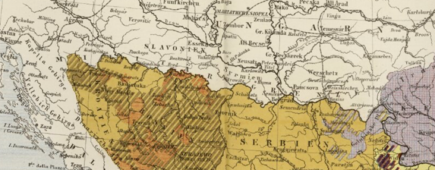Discourses on music at the margins of the Habsburg Monarchy (c. 1750–1914)
This project is about imperial, meta-national, and national discourses on music at the southern military border of the Habsburg Monarchy. The specially protected border space along the lower Danube region, where the Slavonian (1745–1881) and the Banat (1751–1873) Military Frontiers were established to protect the Empire from the Ottoman military operations, allowed for a multi-layered cultural transfer which involved the remote capital (Vienna), the free royal cities in Pannonia as local centers, and the main towns within the border space, as well as the Ottoman Empire beyond the border.
My analysis is based on writings on music, mainly the musical and cultural life, concert and theater guest performances, published in the newspapers in German ("Esseker Lokalblatt und Landbote", "Slawonische Presse" in Slavonia; "Groß-Becskereker Wochenblatt", "Banater Post" in the Banat), in Serbian ("Glas", "Pančevac"), in Croatian ("Virovitičanin", "Sriemski Hrvat") and in Hungarian ("Torontál"), but also in periodicals, anniversary publications of choral societies and theatres, the program notes of music performances, books and later established professional music journals, as well as publications by the first professional musicologists (e.g. Franjo Kuhač). Within the complex pluricultural, i.e. multiethnic, multilingual, and multireligious (Christian – Catholic, Orthodox, and Protestant; Jewish; Muslim heritage) border region, writings on music convey the full panorama of cosmopolitan, imperial, Pan-Slavic, and (meta-)national narratives of different social groups, emerging from the complex network of cultural and administrative institutions within the imperial context (Germans and Croats lived in the Habsburg Monarchy), including the diaspora (Serbs were divided between the Habsburg and Ottoman Empires), also considering a phase of Pan-Slavism (Austroslavism) and general social and sociological aspects.
The project’s theoretical framework is related to the structures of power and the construction of vernacular languages, challenging the concept of identity to provide more profound insights into cultural and social practices. The deeply-rooted nationalist attitude will be counterbalanced by elucidating the multifaceted variety of the – ultimately overlapping – imperial and national perspectives. These served as a basis for various self-representations even among the same national and religious communities and numerous minorities. The cultural and musical activities of settlers in the area between the two empires, including the Slavs (Serbs, Croats, Slovaks), Hungarians, Germans, Romanians, and Jews are also considered.




Project Duration
1 October 2019 – 31 January 2026
Contact
Partner Institutions
